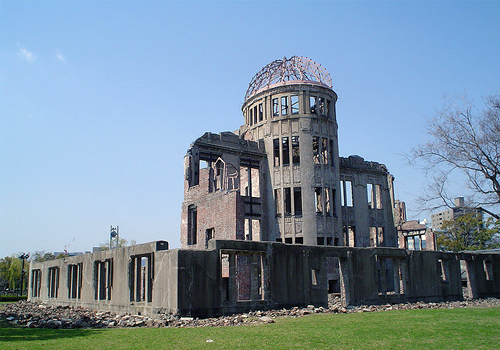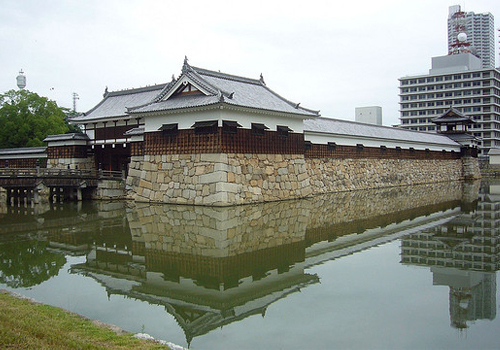Hiroshima Travel Guide
Peace Memorial Park
Address: 1-2 Nakajima-cho, Naka-ku Hiroshima
Admission: ¥50 (adult), ¥30 (child) Museum: daily 8:30am-6pm (March to November); 8:30am-7pm (August); 8:30am-5pm (December to February).
Telephone: Museum: (0)82 242 7798
Around the epicentre of the atomic bomb explosion in Hiroshima in 1945, a complex of buildings and monuments has been erected in the Peace Memorial Park to commemorate the earth-shattering event. It is dedicated to the promotion of world peace. Central to the park is the only remaining city building damaged in the blast. It was formerly the Industrial Promotion Hall, but is now known as the Atomic Bomb Dome and has been declared a UNESCO World Heritage Site. The park also contains the Peace Memorial Museum, featuring exhibits that graphically portray the horrible effects of the bomb on the city and its citizens. Between the museum and the dome stands the Memorial Cenotaph containing a stone chest, inside which is a list of all those killed in the explosion or who died subsequently from the long-term effects caused by radiation. The Cenotaph also houses the peace flame, which will burn until nuclear war is no longer considered a threat to humanity. Other monuments contained in the solemn park include the Statue of the A-Bomb Children and the Atomic Bomb Memorial Mound that contains the ashes of tens of thousands of unidentified victims. The Peace Memorial Park is a must for all those visiting Hiroshima and an important place to mourn, reflect and pay tribute for locals and foreigners alike.<br /><br />
Hiroshima City Museum of Contemporary Art
Address: Hijiyama Koen Hiroshima
Admission: ¥360 (adults), ¥270 (students), ¥170 (scholars). Tuesday to Sunday 10am-5pm.
Telephone: (0)82 264 1121
Hiroshima boasts the first public art museum in Japan devoted exclusively to contemporary art. The museum was founded in 1989 and is housed in an interesting building designed by Japanese architect Kurokawa Kisho, based on the shape of a Japanese warehouse (Kura). The building is set high on a hill in Hijiyama Park, famed for its cherry blossoms and splendid city views. The museum itself contains the works of established and up-and-coming Japanese artists covering a range of different mediums, and hosts regular temporary exhibitions which can be very interesting. For those not familiar with Japanese art the museum has provided information books on the individual artists represented, written in English; however, aside from these, there is very little signposting or information in English. There is an outdoor sculpture garden to enjoy in the lovely grounds, and the Hiroshima Manga Library is also located here. The museum is a little bit out of the way but those interested in contemporary Japanese art should find the effort rewarding, and a stroll in the grounds is pleasant. For the idly curious who are not big art fans, this attraction will probably be a bit dull or bewildering.<br /><br />
Hiroshima Castle
Address: 21-1 Motomachi, Naka-ku Hiroshima
Admission: Castle tower: JPY360 (adults), JPY180 (children). Castle grounds free. Daily 9am to 5.30pm; 9am to 4:30pm (October to March).
Telephone: (0)82 221 7512
Hiroshima's original castle, built in the late 16th century, was totally destroyed in the atomic blast during World War II but has been reconstructed as a perfect replica of the original. When the castle was established by a feudal lord in 1589 Hiroshima didn't exist; the city that grew around the fortress took its name. At the time the area was called Gokamura, meaning five small villages, and the lord ruled over a vast territory spanning nine provinces from the stronghold. The castle now houses a museum detailing the region's history up until World War II and particularly the historic feudal system. The exhibits include some models of ancient Hiroshima and the castle and, for those who like playing dress-up, there are even some traditional costumes to try on. The museum is informative and easy to navigate with plenty of information in English. There is a great lookout point at the top of the castle which affords some nice photo opportunities. The grounds are also lovely, housing three trees, a eucalyptus, a willow, and a holly, which survived the bombing in 1945 and endure to this day. One of the most popular tourist attractions in Hiroshima, the castle is definitely worth a visit for anybody with an interest in history.<br /><br />
Miyajima
Address: Hiroshima
Admission: Itsukushima Shrine: daily 6.30am to 6pm
Telephone: (0)82 944 0008
The romantic little island of Miyajima lies about eight miles (13km) off the mainland in the Seto Inland Sea. Apart from being scenically beautiful with steep wooded hills, the island is famous for its Itsukushima Shrine featuring a massive red wooden torii (gate). The shrine is partially built over water, and was founded in the 6th century. During high tide the shrine stands in the ocean, which is particularly picturesque when the building is illuminated at night. The route from the ferry to the shrine is lined with food stalls and souvenir stands to cater to all the tourists and although the shrine can get crowded it is a charming attraction. The Daishoin Temple is situated about half way up the mountain with incredible views and a pathway strewn with hundreds of statues. There are also temples and shrines near the summit of Mount Misen which are worth exploring. The island offers great hiking opportunities, particularly in spring when the many cherry trees are in bloom, and in autumn, when the colours are at their most vibrant. Deer roam free and monkeys chatter in the woods. Visitors may find the deer a bit of a nuisance as they are very tame and will disrupt picnics by trying to get to your food.<br /><br />
Sandankyo Gorge
Address: Hiroshima
The erosion of the limestone plateau in the northwest of the Hiroshima prefecture has left a beautiful deep gorge, stretching for about 11 miles (18km), full of primeval forest, waterfalls, monkeys, unusual rock formations and the Onbashi Bridge, the largest natural bridge in Japan. Sandankyo Gorge is one of only five ravines in Japan that have been designated as National Scenic Beauty spots and the country takes great pride in the beautiful area, which is a great favorite with hikers. It is closed in winter because snow makes the ravine impassable and dangerous but visitors are welcome between the end of April and November. As with most scenic spots in Japan the ravine is at its most lovely in spring and autumn but is certainly still a worthwhile excursion in summer. One of the most popular walking trails is a round-trip that begins at the Sandan-kyo front gate with the lovely Kurofuchi pool as the turning point. The hike only takes about an hour each way and is not overly strenuous. The Kurofuchi pool is known for its emerald green water and it is possible to take a short ferry ride across it to a restaurant on the far bank. On this route you will also see the stunning Shimai waterfall and Ishidoi rapids.<br /><br />
| Saturday, November 2, 2019 | Sunday, November 3, 2019 | Monday, November 4, 2019 |
|---|---|---|
| -1° | 2° | 0° |
(Data provided outside US and Canada by Foreca, Data provided for US and Canada by WDT)
| Jan | Feb | Mar | Apr | May | Jun | Jul | Aug | Sep | Oct | Nov | Dec | |
| Average High | 8° | 8° | 12° | 17° | 21° | 25° | 28° | 30° | 26° | 21° | 16° | 11° |
| Average Low | 1° | 1° | 4° | 9° | 13° | 18° | 23° | 23° | 20° | 13° | 8° | 3° |
(Data provided outside US and Canada by Foreca, Data provided for US and Canada by WDT)
| Jan | Feb | Mar | Apr | May | Jun | Jul | Aug | Sep | Oct | Nov | Dec | |
| Average High | 47° | 48° | 54° | 64° | 71° | 77° | 84° | 87° | 80° | 71° | 61° | 52° |
| Average Low | 35° | 35° | 40° | 49° | 57° | 66° | 74° | 75° | 68° | 57° | 47° | 39° |


